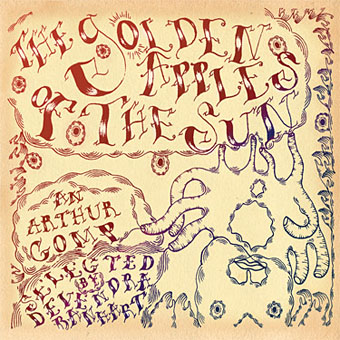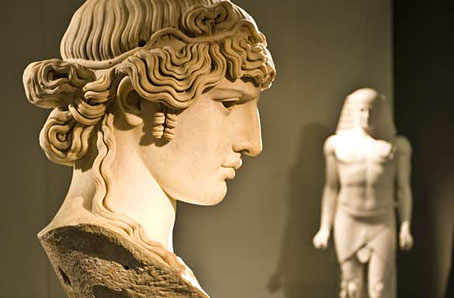The Golden Apples of the Sun, the first release on Arthur Magazine‘s Bastet label has been one of my favourite compilations of recent years. Golden Apples was/is one of those landmark music anthologies that appear from time to time and seem to fix a moment perfectly as they capture a sudden flourishing of new music, in this instance the emergence of folk/acoustic/post-Old Weird America bands and artists. Devendra Banhart is one of those artists and he compiled the anthology and produced the cover art. The first pressing sold out but it’s now being reissued and you can order a copy here.
This is more than a compilation–it’s expertly sequenced and paced, like one long, slow flow of a particularly rich vibe. Liner notes are by the artists themselves, paying tribute to each other, all handlettered by Devendra, who also provides artwork on cover, back cover, sleeve, tray and the disk itself.
“Essential.” — Mojo, September 2004
“Sparkling.” — The Wire, July 2004
“8.6 (out of 10): [Its] sprawling landscape presents a persuasive case for the depth of a scene that seemingly sprung up (like mushrooms) overnight.” — Pitchfork, July 8, 2004
Track listing:
1. Vetiver (with Hope Sandoval) – “Angel’s Share” (from the “Vetiver” LP)
2. Joanna Newsom – “Bridges and Balloons” (from “The Milk–Eyed Mender” LP)
3. Six Organs of Admittance – “Hazy SF” (previously unreleased)
4. Viking Moses – “Crosses” (from “Crosses”)
5. Josephine Foster – “Little Life” (prev. unreleased home recording)
6. ESPers – “Byss & Abyss” (from “ESPers” LP)
7. Vashti Bunyan & Devendra Banhart – “Rejoicing in the Hands” (from the “Rejoicing in the Hands of the Golden Empress” LP)
8. Jana Hunter – “Farm, CA” (prev. unreleased)
9. Currituck Co. – “The Tropics of Cancer” (from “Ghost Man on First”)
10. White Magic – “Don’t Need” (from the Drag City EP)
11. Iron and Wine – “Fever Dream” (from “Our Endless Numbered Days” LP)
12. Diane Cluck – ” Heat From Every Corner” (from “Macy’s Day Bird”)
13. Matt Valentine – “Mountains of Yaffa” (prev. unreleased)
14. Entrance – “You Must Turn” (prev. unreleased home recording)
15. Jack Rose – “White Mule” (from “Red Horse, White Mule”)
16. Little Wings – “Look at What the Light Did Now” (from “Light Green Leaves”)
17. Scout Niblett – “Wet Road” (from “Sweet Heart Fever”)
18. Troll – “Mexicana” (from “Pathless Lord”)
19. CocoRosie – “Good Friday” (from “La Maison de Mon Reve”)
20. Antony – “The Lake” (from “Live at Saint Olaye’s With Current 93”)
Previously on { feuilleton }
• So Much Fire to Roast Human Flesh
• Summer of Love Redux



